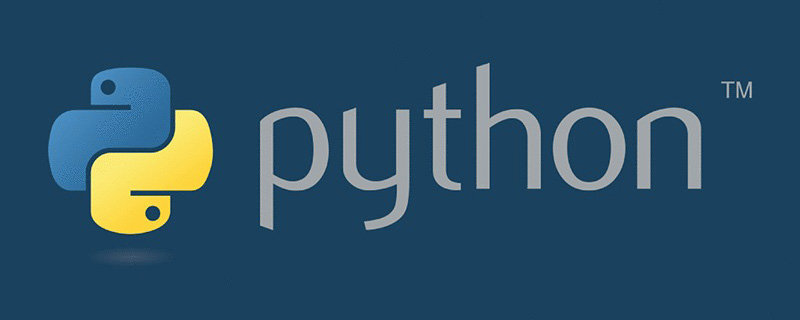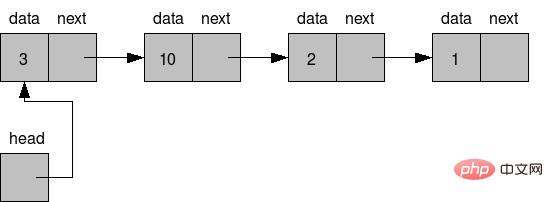 Backend Development
Backend Development
 Python Tutorial
Python Tutorial
 How to insert and output nodes in python singly linked list? (code example)
How to insert and output nodes in python singly linked list? (code example)
How to insert and output nodes in python singly linked list? (code example)
How to insert and output nodes in python singly linked list? The following article will help you understand what a singly linked list is and how to perform some very basic operations on a singly linked list, such as insertion and output. I hope it will be helpful to you.

What is a singly linked list?
First of all, before understanding the singly linked list, we must understand what a node is.
Node is the building block of the linked list, which consists of two parts:
1. Data part: used to contain data
2. Address part: used to point to the next Pointer to the node location.
In a singly linked list, the address portion of each node contains information about the location of the next node; this forms a series of chains or links. The first node of the linked list is tracked by the head pointer; the last node points to None.
Let’s look at the diagram below to understand this better:

Note: In the above diagram, the last element 1 points to None. Even though these nodes are drawn contiguously with each other, they may or may not actually be in contiguous memory locations.
How to insert and output nodes in a singly linked list?
1. Create a singly linked list
First, you must create a node to create a singly linked list. To do this, we create a Node class using data and nextNode properties. As mentioned before, the data attribute will contain the data and nextNode will simply point to the next node in the linked list. We set the default value for nextNode to be None. You can use getter and setter methods to do this.
Now that the Node class has been created, it is time to create the LinkedList class. This has only one attribute, head. By default this will point to "None". If the header points to "None", it means that the linked list is empty. To keep track of the number of nodes in the linked list, we can add a size attribute to the LinkedList class and default it to 0.
2. Insert node
This is the method of LinkedList class. We can insert a new node anywhere in the linked list, but to keep the coding simple and efficient, we will always add new nodes to the beginning of the linked list; in other words, the head will always point to the most recently added node.
If we add a new node to the end of the list, we need to perform extra work to find the end of the list and then add it. This is a wasteful operation. However, this can be done if you maintain another pointer, let's call it tail pointer, pointing to the last node.
Below we introduce the former method, that is, how to insert a node at the beginning of the linked list.
Suppose we need to add 7 to the linked list, we need to perform the following steps:
● Create a node object, where 7 represents data, and the next node points to the head node
● Point the head pointer to this new node
Finally, increase the size attribute by 1. If the insertion is successful, return True. This is a good habit; this way, the user knows what happened.
3. Output node
This is the method of LinkedList class. To print the data in all nodes in the linked list, we need to iterate through one node at a time and print the data portion of each node.
Implementation code:
class Node:
def __init__(self,data,nextNode=None):
self.data = data
self.nextNode = nextNode
def getData(self):
return self.data
def setData(self,val):
self.data = val
def getNextNode(self):
return self.nextNode
def setNextNode(self,val):
self.nextNode = val
class LinkedList:
def __init__(self,head = None):
self.head = head
self.size = 0
def getSize(self):
return self.size
def addNode(self,data):
newNode = Node(data,self.head)
self.head = newNode
self.size+=1
return True
def printNode(self):
curr = self.head
while curr:
print(curr.data)
curr = curr.getNextNode()
myList = LinkedList()
print("Inserting")
print(myList.addNode(5))
print(myList.addNode(15))
print(myList.addNode(25))
print("Printing")
myList.printNode()
print("Size")
print(myList.getSize())What are the advantages and disadvantages of singly linked lists?
Advantages:
● It is a dynamic data structure in which insertion and deletion are simple. Because we don't need to move the element. Just updating the next pointer will do the job.
● Stack and queue data structures can be easily implemented using linked lists.
Disadvantages
● The next pointer occupies additional memory.
●Cannot be accessed randomly. The linked list must be traversed from the beginning to reach a specific node.
The above is the entire content of this article, I hope it will be helpful to everyone's study. For more exciting content, you can pay attention to the relevant tutorial columns of the PHP Chinese website! ! !
The above is the detailed content of How to insert and output nodes in python singly linked list? (code example). For more information, please follow other related articles on the PHP Chinese website!

Hot AI Tools

Undresser.AI Undress
AI-powered app for creating realistic nude photos

AI Clothes Remover
Online AI tool for removing clothes from photos.

Undress AI Tool
Undress images for free

Clothoff.io
AI clothes remover

Video Face Swap
Swap faces in any video effortlessly with our completely free AI face swap tool!

Hot Article

Hot Tools

Notepad++7.3.1
Easy-to-use and free code editor

SublimeText3 Chinese version
Chinese version, very easy to use

Zend Studio 13.0.1
Powerful PHP integrated development environment

Dreamweaver CS6
Visual web development tools

SublimeText3 Mac version
God-level code editing software (SublimeText3)

Hot Topics
 PHP and Python: Different Paradigms Explained
Apr 18, 2025 am 12:26 AM
PHP and Python: Different Paradigms Explained
Apr 18, 2025 am 12:26 AM
PHP is mainly procedural programming, but also supports object-oriented programming (OOP); Python supports a variety of paradigms, including OOP, functional and procedural programming. PHP is suitable for web development, and Python is suitable for a variety of applications such as data analysis and machine learning.
 Choosing Between PHP and Python: A Guide
Apr 18, 2025 am 12:24 AM
Choosing Between PHP and Python: A Guide
Apr 18, 2025 am 12:24 AM
PHP is suitable for web development and rapid prototyping, and Python is suitable for data science and machine learning. 1.PHP is used for dynamic web development, with simple syntax and suitable for rapid development. 2. Python has concise syntax, is suitable for multiple fields, and has a strong library ecosystem.
 PHP and Python: A Deep Dive into Their History
Apr 18, 2025 am 12:25 AM
PHP and Python: A Deep Dive into Their History
Apr 18, 2025 am 12:25 AM
PHP originated in 1994 and was developed by RasmusLerdorf. It was originally used to track website visitors and gradually evolved into a server-side scripting language and was widely used in web development. Python was developed by Guidovan Rossum in the late 1980s and was first released in 1991. It emphasizes code readability and simplicity, and is suitable for scientific computing, data analysis and other fields.
 Python vs. JavaScript: The Learning Curve and Ease of Use
Apr 16, 2025 am 12:12 AM
Python vs. JavaScript: The Learning Curve and Ease of Use
Apr 16, 2025 am 12:12 AM
Python is more suitable for beginners, with a smooth learning curve and concise syntax; JavaScript is suitable for front-end development, with a steep learning curve and flexible syntax. 1. Python syntax is intuitive and suitable for data science and back-end development. 2. JavaScript is flexible and widely used in front-end and server-side programming.
 How to run sublime code python
Apr 16, 2025 am 08:48 AM
How to run sublime code python
Apr 16, 2025 am 08:48 AM
To run Python code in Sublime Text, you need to install the Python plug-in first, then create a .py file and write the code, and finally press Ctrl B to run the code, and the output will be displayed in the console.
 Can vs code run in Windows 8
Apr 15, 2025 pm 07:24 PM
Can vs code run in Windows 8
Apr 15, 2025 pm 07:24 PM
VS Code can run on Windows 8, but the experience may not be great. First make sure the system has been updated to the latest patch, then download the VS Code installation package that matches the system architecture and install it as prompted. After installation, be aware that some extensions may be incompatible with Windows 8 and need to look for alternative extensions or use newer Windows systems in a virtual machine. Install the necessary extensions to check whether they work properly. Although VS Code is feasible on Windows 8, it is recommended to upgrade to a newer Windows system for a better development experience and security.
 Where to write code in vscode
Apr 15, 2025 pm 09:54 PM
Where to write code in vscode
Apr 15, 2025 pm 09:54 PM
Writing code in Visual Studio Code (VSCode) is simple and easy to use. Just install VSCode, create a project, select a language, create a file, write code, save and run it. The advantages of VSCode include cross-platform, free and open source, powerful features, rich extensions, and lightweight and fast.
 Can visual studio code be used in python
Apr 15, 2025 pm 08:18 PM
Can visual studio code be used in python
Apr 15, 2025 pm 08:18 PM
VS Code can be used to write Python and provides many features that make it an ideal tool for developing Python applications. It allows users to: install Python extensions to get functions such as code completion, syntax highlighting, and debugging. Use the debugger to track code step by step, find and fix errors. Integrate Git for version control. Use code formatting tools to maintain code consistency. Use the Linting tool to spot potential problems ahead of time.





